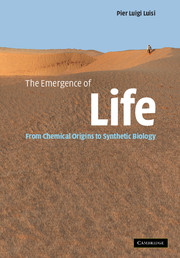Book contents
- Frontmatter
- Contents
- Preface
- Acknowledgments
- List of books on the origin of life
- 1 Conceptual framework of research on the origin of life on Earth
- 2 Approaches to the definitions of life
- 3 Selection in prebiotic chemistry: why this … and not that?
- 4 The bottle neck: macromolecular sequences
- 5 Self-organization
- 6 The notion of emergence
- 7 Self-replication and self-reproduction
- 8 Autopoiesis: the logic of cellular life
- 9 Compartments
- 10 Reactivity and transformation of vesicles
- 11 Approaches to the minimal cell
- Outlook
- References
- Index
2 - Approaches to the definitions of life
Published online by Cambridge University Press: 17 December 2010
- Frontmatter
- Contents
- Preface
- Acknowledgments
- List of books on the origin of life
- 1 Conceptual framework of research on the origin of life on Earth
- 2 Approaches to the definitions of life
- 3 Selection in prebiotic chemistry: why this … and not that?
- 4 The bottle neck: macromolecular sequences
- 5 Self-organization
- 6 The notion of emergence
- 7 Self-replication and self-reproduction
- 8 Autopoiesis: the logic of cellular life
- 9 Compartments
- 10 Reactivity and transformation of vesicles
- 11 Approaches to the minimal cell
- Outlook
- References
- Index
Summary
Introduction
In this chapter two related questions will be considered. Firstly, the definition(s) of life; secondly, the ideas on how to implement such views on life in the laboratory. The idea of defining life is generally met with scepticism or benevolent nods by a large number of scientists. The arguments behind this negative attitude are various: such an enterprise is deemed neither useful nor easy, since everybody knows what life is, but to describe it in words is impossible. A slightly more sophisticated argument is based on the assertion that the transition from non-life to life is a continuous process, and therefore the discrimination between the living and the non-living is impracticable.
This negative attitude has several components, which have been partly analyzed (Luisi, 1998). One main problem is that the term “life” is too vague and general, and loaded with a number of historical, traditional, religious values. In particular, in the Christian tradition, the term life is generally linked to the notion of soul – and in Buddhism is linked to the notion of consciousness.
Of course, this is too much of a big picture and to define life at this level may indeed appear impossible. However, one can scientifically tackle this question by looking at life in its simplest expression, namely microbes and other unicellular organisms. This is a first, important clarification, which also eliminates (at least for most scientists) the notions of soul or consciousness from the picture.
- Type
- Chapter
- Information
- The Emergence of LifeFrom Chemical Origins to Synthetic Biology, pp. 17 - 37Publisher: Cambridge University PressPrint publication year: 2006



